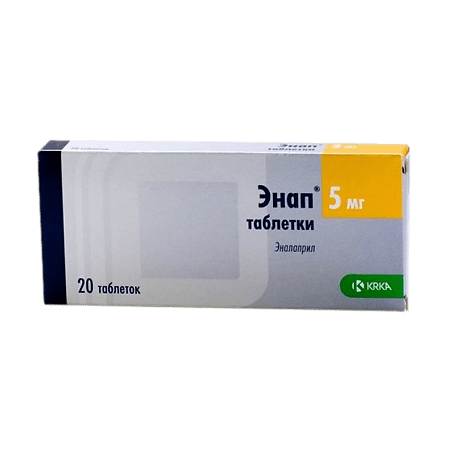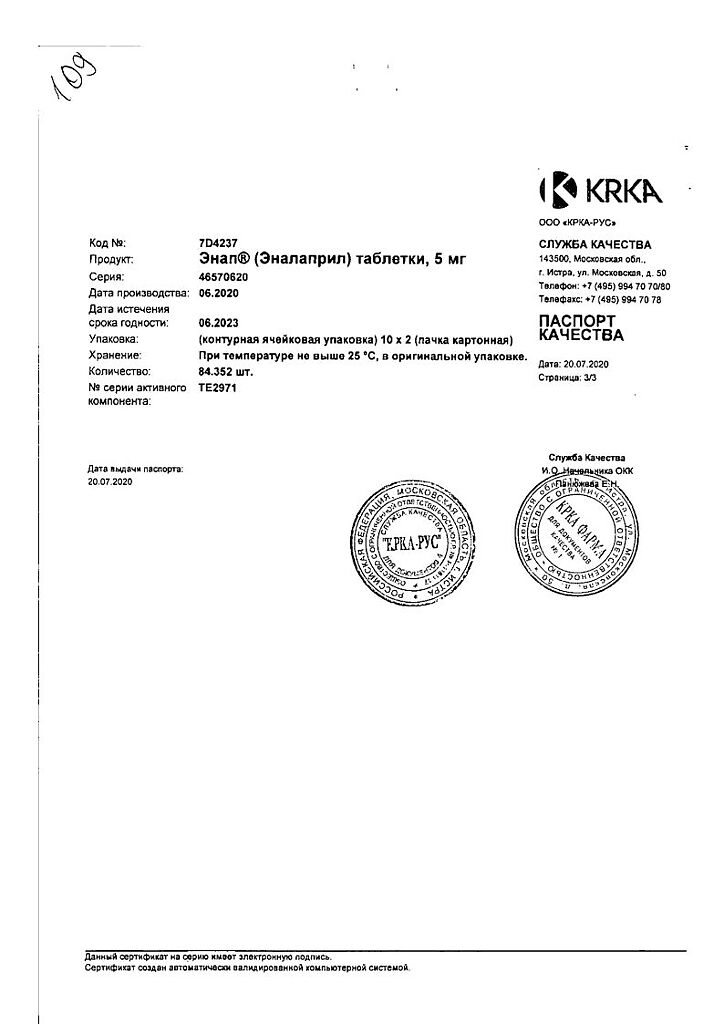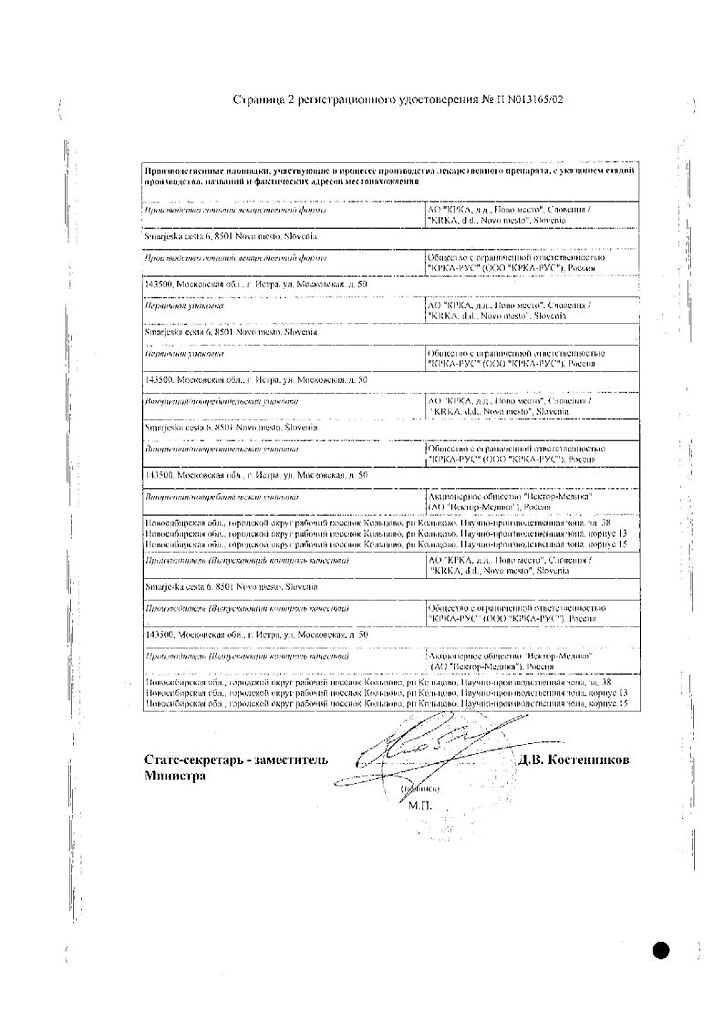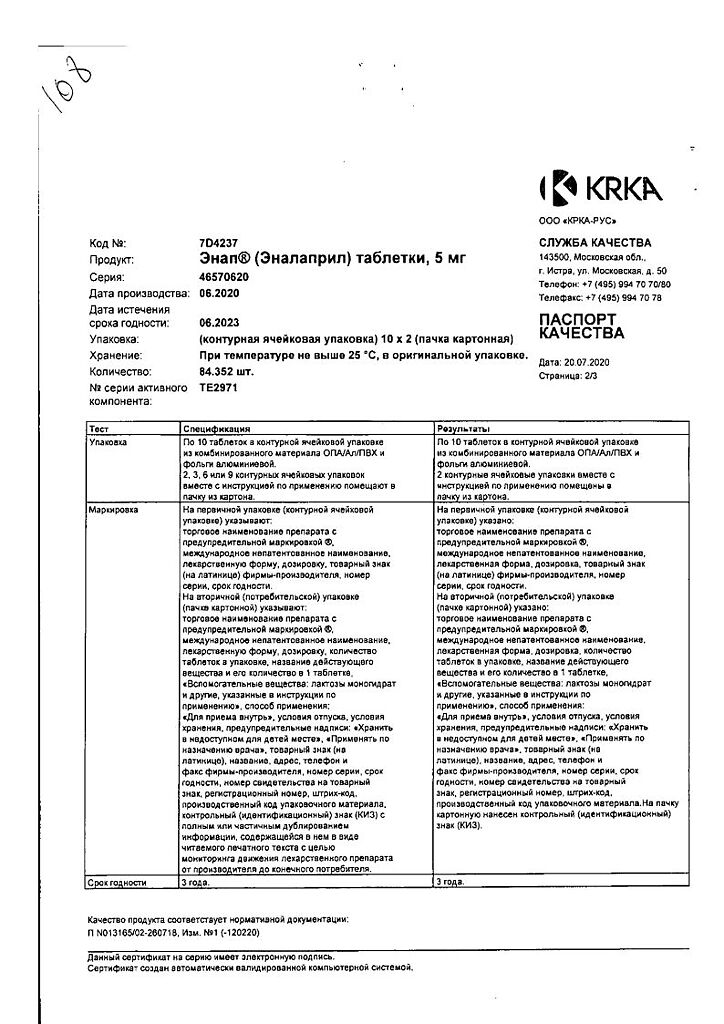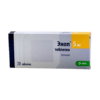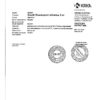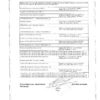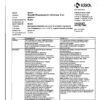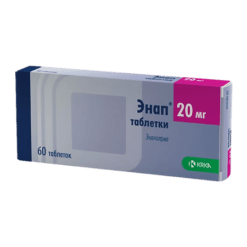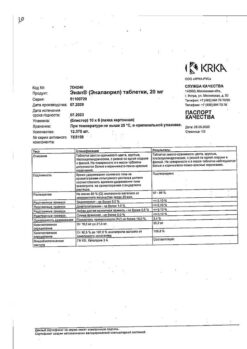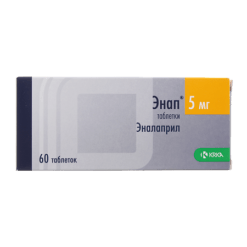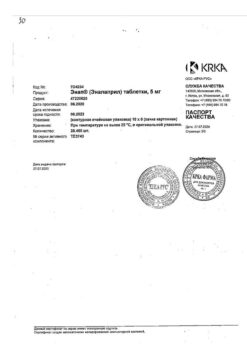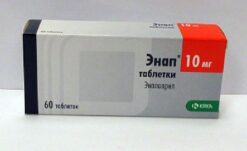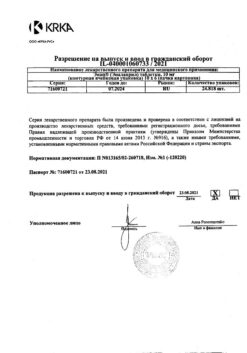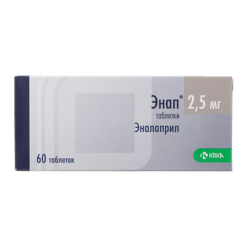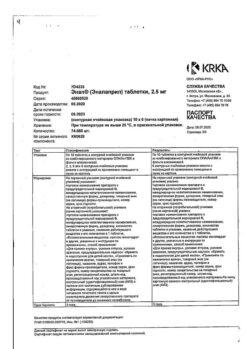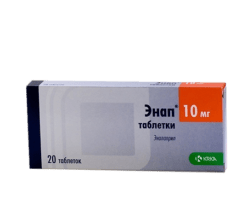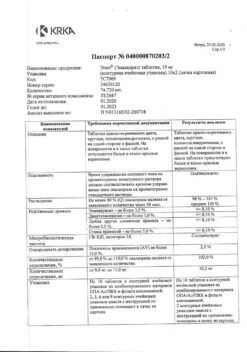No products in the cart.
Enap, tablets 5 mg 20 pcs
€1.64 €1.49
Description
Enap is an antihypertensive drug whose mechanism of action is associated with inhibition of angiotensin-converting enzyme activity, resulting in reduction of angiotensin-II formation.
Enalapril is a “prodrug”: as a result of its hydrolysis it produces enalaprilate which inhibits ACE. Its mechanism of action is related to the reduction of angiotensin I to angiotensin II, the reduction of which leads to a direct reduction of aldosterone secretion. This decreases total peripheral vascular resistance, systolic and diastolic blood pressure (BP), post- and preload on myocardium.
Dilates arteries to a greater extent than veins, and there is no reflex increase in heart rate.
The hypotensive effect is more pronounced at high plasma renin levels than at normal or reduced levels. Reduction of blood pressure (BP) within therapeutic limits has no effect on the cerebral blood flow, the blood flow in the brain vessels is maintained at a sufficient level even against the background of reduced blood pressure. It enhances coronary and renal blood flow.
Long-term use reduces hypertrophy of the left ventricular myocardium and myocytes of the resistive arterial walls, prevents the progression of heart failure and slows the development of left ventricular dilatation. Improves blood supply to ischemic myocardium. Reduces platelet aggregation.
It has some diuretic effect.
The time of onset of hypotensive effect when taken orally is 1 hour, reaches a maximum after 4-6 hours and lasts up to 24 hours. In some patients, therapy for several weeks is necessary to achieve optimal blood pressure levels. In cardiac insufficiency noticeable clinical effect is observed with long-term use – 6 months or more.
Indications
Indications
Arterial hypertension (including renovascular), chronic heart failure (as part of combination therapy).
Prevention of the development of clinically significant heart failure in patients with asymptomatic left ventricular dysfunction (as part of combination therapy).
Prevention of coronary ischemia in patients with left ventricular dysfunction in order to reduce the incidence of myocardial infarction and reduce the frequency of hospitalizations for unstable angina.
Pharmacological effect
Pharmacological effect
Pharmacotherapeutic group: ACE blocker
Pharmacological action
ACE inhibitor. It is a prodrug from which the active metabolite enalaprilat is formed in the body. It is believed that the mechanism of antihypertensive action is associated with competitive inhibition of ACE activity, which leads to a decrease in the rate of conversion of angiotensin I to angiotensin II (which has a pronounced vasoconstrictor effect and stimulates the secretion of aldosterone in the adrenal cortex).
As a result of a decrease in the concentration of angiotensin II, a secondary increase in plasma renin activity occurs due to the elimination of negative feedback during the release of renin and a direct decrease in aldosterone secretion. In addition, enalaprilat appears to have an effect on the kinin-kallikrein system, preventing the breakdown of bradykinin.
Thanks to its vasodilating effect, it reduces roundabout percentage (afterload), wedge pressure in the pulmonary capillaries (preload) and resistance in the pulmonary vessels; increases cardiac output and exercise tolerance.
In patients with chronic heart failure, with long-term use, enalapril increases exercise tolerance and reduces the severity of heart failure (assessed by NYHA criteria). Enalapril in patients with mild to moderate heart failure slows its progression and also slows down the development of left ventricular dilatation. In case of left ventricular dysfunction, enalapril reduces the risk of major ischemic outcomes (including the incidence of myocardial infarction and the number of hospitalizations for unstable angina).
Pharmacokinetics
When taken orally, about 60% is absorbed from the gastrointestinal tract. Concomitant food intake does not affect absorption. Metabolized in the liver by hydrolysis with the formation of enalaprilat, due to the pharmacological activity of which a hypotensive effect is realized. The binding of enalaprilat to plasma proteins is 50-60%.
T1/2 of enalaprilat is 11 hours and increases with renal failure. After oral administration, 60% of the dose is excreted by the kidneys (20% as enalapril, 40% as enalaprilat), 33% is excreted through the intestines (6% as enalapril, 27% as enalaprilat). After intravenous administration of enalaprilat, 100% is excreted unchanged by the kidneys.
Special instructions
Special instructions
Use with extreme caution in patients with autoimmune diseases, diabetes mellitus, liver dysfunction, severe aortic stenosis, subaortic muscular stenosis of unknown origin, hypertrophic cardiomyopathy, and loss of fluid and salts. In the case of previous treatment with saluretics, in particular in patients with chronic heart failure, the risk of developing orthostatic hypotension increases, therefore, before starting treatment with enalapril, it is necessary to compensate for the loss of fluid and salts.
With long-term treatment with enalapril, it is necessary to periodically monitor the peripheral blood picture. Sudden cessation of enalapril does not cause a sharp increase in blood pressure.
During surgical interventions during treatment with enalapril, arterial hypotension may develop, which should be corrected by administering a sufficient amount of fluid.
Before studying the function of the parathyroid glands, enalapril should be discontinued.
Impact on the ability to drive vehicles and machinery
Caution is required when driving vehicles or performing other work that requires increased attention, because Dizziness may occur, especially after taking the initial dose of enalapril.
Active ingredient
Active ingredient
Enalapril
Composition
Composition
Active substance: enalapril
Excipients: sodium bicarbonate – 2.6 mg, lactose monohydrate – 129.8 mg, corn starch – 22.4 mg, hyprolose – 2.5 mg, talc – 6 mg, magnesium stearate – 1.7 mg.
Pregnancy
Pregnancy
Contraindicated for use during pregnancy. If pregnancy occurs, enalapril should be stopped immediately.
Enalapril is excreted in breast milk. If it is necessary to use it during lactation, the issue of stopping breastfeeding should be decided.
Contraindications
Contraindications
History of angioedema, bilateral renal artery stenosis or renal artery stenosis of a single kidney, hyperkalemia, porphyria, simultaneous use with aliskiren in patients with diabetes mellitus or impaired renal function (creatinine clearance < 60 ml/min), pregnancy, lactation (breastfeeding), children and adolescents under 18 years of age, hypersensitivity to enalapril and other inhibitors APF.
Side Effects
Side Effects
From the nervous system: dizziness, headache, feeling of fatigue, increased fatigue; very rarely when used in high doses – sleep disorders, nervousness, depression, imbalance, paresthesia, tinnitus.
From the cardiovascular system: orthostatic hypotension, fainting, palpitations, pain in the heart; very rarely when used in high doses – hot flashes.
From the digestive system: nausea; rarely – dry mouth, abdominal pain, vomiting, diarrhea, constipation, impaired liver function, increased activity of liver transaminases, increased concentration of bilirubin in the blood, hepatitis, pancreatitis; very rarely when used in high doses – glossitis.
From the hematopoietic system: rarely – neutropenia; in patients with autoimmune diseases – agranulocytosis.
From the urinary system: rarely – renal dysfunction, proteinuria.
From the respiratory system: dry cough.
From the reproductive system: very rarely, when used in high doses – impotence.
Dermatological reactions: very rarely when used in high doses – hair loss.
Allergic reactions: rarely – skin rash, Quincke’s edema.
Other: rarely – hyperkalemia, muscle cramps.
Interaction
Interaction
When used simultaneously with immunosuppressants and cytostatics, the risk of developing leukopenia increases.
With the simultaneous use of potassium-sparing diuretics (including spironolactone, triamterene, amiloride), potassium supplements, salt substitutes and dietary supplements containing potassium, hyperkalemia may develop (especially in patients with impaired renal function), because ACE inhibitors reduce the content of aldosterone, which leads to potassium retention in the body while limiting the excretion of potassium or its additional intake into the body.
With the simultaneous use of opioid analgesics and anesthetics, the antihypertensive effect of enalapril is enhanced.
With the simultaneous use of loop diuretics and thiazide diuretics, the antihypertensive effect is enhanced. There is a risk of developing hypokalemia. Increased risk of kidney dysfunction.
When used simultaneously with azathioprine, anemia may develop, which is due to inhibition of erythropoietin activity under the influence of ACE inhibitors and azathioprine.
A case of the development of an anaphylactic reaction and myocardial infarction with the use of allopurinol in a patient receiving enalapril has been described.
Acetylsalicylic acid in high doses may reduce the antihypertensive effect of enalapril.
It has not been conclusively established whether acetylsalicylic acid reduces the therapeutic effectiveness of ACE inhibitors in patients with coronary artery disease and heart failure. The nature of this interaction depends on the course of the disease.
Acetylsalicylic acid, by inhibiting COX and prostaglandin synthesis, can cause vasoconstriction, which leads to a decrease in cardiac output and worsening of the condition of patients with heart failure receiving ACE inhibitors.
With the simultaneous use of beta-blockers, methyldopa, nitrates, calcium channel blockers, hydralazine, prazosin, the antihypertensive effect may be enhanced.
When used simultaneously with NSAIDs (including indomethacin), the antihypertensive effect of enalapril is reduced, apparently due to inhibition of the synthesis of prostaglandins under the influence of NSAIDs (which are believed to play a role in the development of the hypotensive effect of ACE inhibitors). The risk of developing renal dysfunction increases; Hyperkalemia is rarely observed.
With the simultaneous use of insulin, hypoglycemic agents and sulfonylurea derivatives, hypoglycemia may develop.
With simultaneous use of ACE inhibitors and interleukin-3, there is a risk of developing arterial hypotension.
Syncope has been reported when used concomitantly with clozapine.
When used simultaneously with clomipramine, an increase in the effect of clomipramine and the development of toxic effects have been reported.
When used simultaneously with co-trimoxazole, cases of hyperkalemia have been described.
When used simultaneously with lithium carbonate, the concentration of lithium in the blood serum increases, which is accompanied by symptoms of lithium intoxication.
When used simultaneously with orlistat, the antihypertensive effect of enalapril is reduced, which can lead to a significant increase in blood pressure and the development of a hypertensive crisis.
It is believed that when used simultaneously with procainamide, there may be an increased risk of developing leukopenia.
When used simultaneously with enalapril, the effect of drugs containing theophylline is reduced.
There are reports of the development of acute renal failure in patients after kidney transplantation when used simultaneously with cyclosporine.
When used simultaneously with cimetidine, the T1/2 of enalapril increases and its concentration in the blood plasma increases.
It is believed that the effectiveness of antihypertensive drugs may be reduced when used simultaneously with erythropoietins.
When used simultaneously with ethanol, the risk of developing arterial hypotension increases.
Manufacturer
Manufacturer
KRKA-RUS, Russia
Additional information
| Shelf life | 3 years |
|---|---|
| Conditions of storage | In a dry place, at a temperature not exceeding 25 °C |
| Manufacturer | KRKA-RUS, Russia |
| Medication form | pills |
| Brand | KRKA-RUS |
Other forms…
Related products
Buy Enap, tablets 5 mg 20 pcs with delivery to USA, UK, Europe and over 120 other countries.

